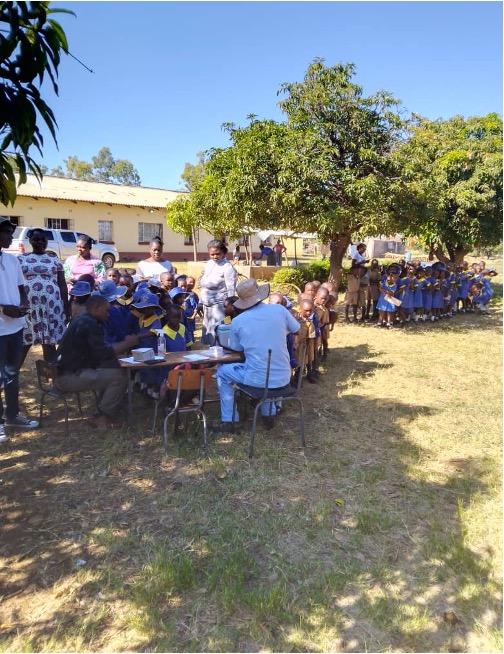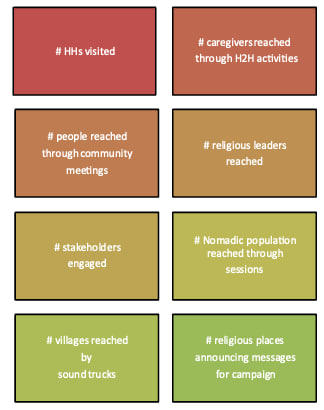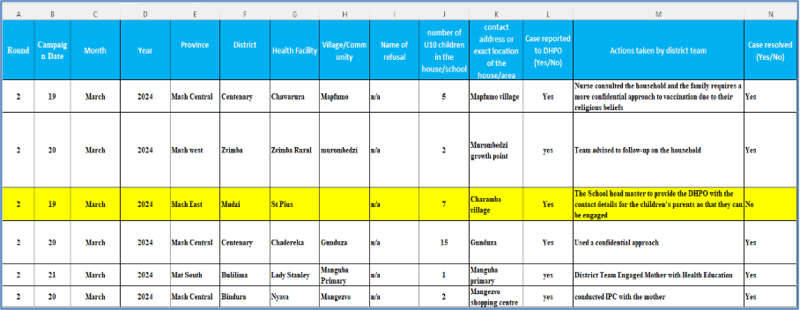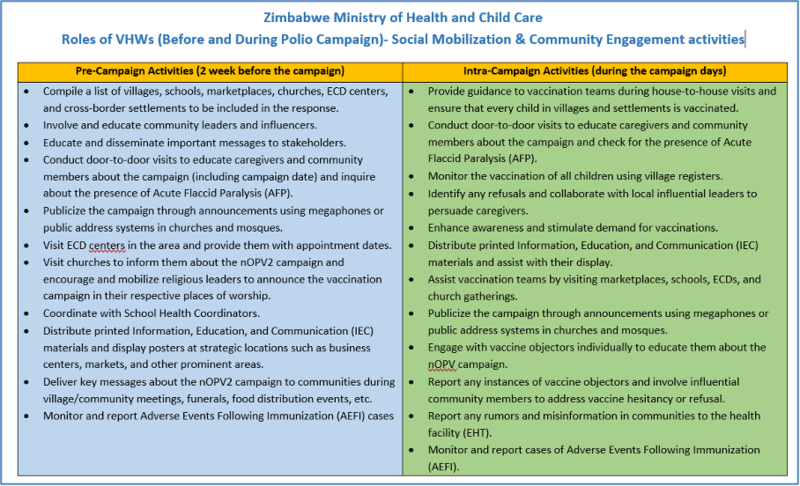Strategic Social and Behavior Change Initiatives in Zimbabwe's Polio Vaccination Efforts
Summary
This article discusses the strategic social and behavior change initiatives in Zimbabwe's polio vaccination efforts, highlighting the challenges, strategies, and results of these efforts.
Strategic Social and Behavior Change Initiatives in Zimbabwe's Polio Vaccination Efforts
In 2023, Zimbabwe grappled with a significant public health crisis following the detection of circulating Vaccine Derived Polio Virus 2 (cVDPV2) from three out of five Polio Environmental Surveillance sites in Harare. This discovery was particularly concerning as it coincided with a resurgence of other vaccine-preventable diseases, including measles and diphtheria, alongside a cholera outbreak, further straining the public health infrastructure. In response, on October 26, 2023, the Ministry of Health and Child Care (MOHCC) declared the cVDPV2 outbreak a Public Health Emergency of International Concern.
Prompted by the urgency of the situation, MOHCC planned three Supplementary Immunization Activities (SIAs) with the novel Oral Polio Vaccine type 2 (nOPV2) set to commence in early 2024. This initiative was underpinned by a robust Social and Behavior Change (SBC) strategy, critical to informing and mobilizing communities about the risks associated with polio and the importance of the upcoming vaccination campaign. UNICEF Zimbabwe played a pivotal role in assisting the MOHCC to deploy effective SBC tools and strategies. These efforts were aimed at fostering positive behavior change within communities and among caregivers by addressing various challenges through influencing attitudes, beliefs, and behaviors, ensuring broad support and acceptance of the vaccination program.
Strategies
The comprehensive SBC approach employed by the Ministry of Health and Child Care, with support from UNICEF Zimbabwe, integrated several innovative tools and strategies to confront the polio outbreak effectively. This strategy integrated several innovative tools and coordinated activities, each meticulously designed to meet the specific challenges posed by the outbreak. Demonstrating a tailored approach to crisis management, these efforts enhanced community engagement and optimized public health responses across diverse socio-cultural landscapes.
- Social Data Mapping: Utilizes community profiling to identify key stakeholders and optimize engagement across diverse social and cultural settings, enhancing the reach and impact of health messages.
- Performance Tracking for Village Health Workers (VHWs): Monitors and evaluates the activities of health workers, ensuring accountability and effectiveness in their outreach efforts.
- Refusals Tracking and Management System: Captures and addresses reasons for vaccine hesitancy, allowing for real-time adjustments and targeted communication strategies.
- High-Risk Operational Plan (HROP): Targets low-performing districts with specific interventions, aiming to overcome barriers to vaccine coverage and improve overall immunization rates.
- Distribution of Educational Materials: Provides essential information and guidelines through materials like the VHWs' pocket guide, ensuring consistency in messaging and facilitating informed community participation.

Social Data Mapping
Social Data Mapping serves as a dynamic tool within the SBC strategy, meticulously capturing a comprehensive landscape of existing stakeholders, community-based organizations (CBOs), and critical social gathering points. This tool is designed to delve deeply into the social fabric of communities, understanding interactions, relationships, and behaviors that are pivotal for engaging various groups effectively. The essence of social data mapping lies in its ability to facilitate planned, systematic, and efficient community engagement, thereby ensuring the wider dissemination of key health messages across diverse population segments.
- Stakeholders & Influencers Mapping: Identifying pivotal figures in community dynamics such as local leaders, traditional authorities, and religious influencers.
- Community Hubs: Mapping essential social structures including churches, mosques, markets, and business places.
- Educational and Health Facilities: Detailing locations of schools (both government and private), early childhood development (ECD) centers, and health facilities including private health providers.
- Transport and Migration Points: Including bus stations, border crossings, and areas frequented by nomadic populations.
- Public Utilities and Resources: Identifying water points, playgrounds, and food distribution centers crucial for community gatherings and interactions.
|
Elements of social mapping tool |
|
|
|
This data, collected meticulously at the operational level, supports microplanning processes and underpins a robust social mobilization effort. In Zimbabwe, such efforts have significantly boosted demand among caregivers for the nOPV2 vaccine, particularly for children under 10 years. During the second round of the nationwide nOPV2 drive from March 19-22, 2024, at Research Primary School in the Kadoma district of Mashonaland West province, the effective use of social data mapping was evident. The targeted orientation and sensitization provided to school coordinators were instrumental in creating a supportive environment that facilitated a successful vaccination campaign.

Village Health Workers (VHWs) Activities Reporting Tool
To ensure the efficacy and impact of village health workers (VHWs), a sophisticated activities reporting tool was introduced. This tool captures performance-related data during the vaccination campaign, providing a robust foundation for an accountability system. By documenting outcomes and deliverables, this tool enables precise assessment and appreciation of the VHWs' efforts, reinforcing their pivotal role in community engagement and social mobilization. The introduction of this data collection tool has not only streamlined the process but has also provided crucial evidence on the roles and activities accomplished by the VHWs, enhancing the overall effectiveness of the campaign.
Refusals Tracking and Management System
A critical component of the SBC toolkit is the online system designed for recording and managing vaccine refusals or 'objectors' during the campaign. This system plays a key role in identifying the underlying reasons for vaccine hesitancy, enabling health teams to tailor their strategies effectively. By understanding specific community concerns and misconceptions, health promotion teams can deploy customized communication strategies that significantly boost vaccine acceptance and uptake rates.

High-Risk Operational Plan (HROP)
The High-Risk Operational Plan (HROP) is a strategic initiative designed to target districts that have consecutively failed the Lot Quality Assurance Sampling (LQAS). This comprehensive plan is vital in addressing and overcoming specific challenges in areas with historically low vaccination coverage. The HROP meticulously assesses potential operational challenges to develop tailored Social and Behavior Change (SBC) strategies, aiming to dramatically enhance the quality and coverage of the vaccination response to meet global standards.
Key Components of the HROP include:
- Identification of High-Risk Settlements: Pinpointing specific areas that require urgent attention due to their risk profiles.
- Critical Issues and Impediments: Analyzing barriers that prevent achieving over 95% vaccination coverage.
- Root Cause Analysis: Delving into the underlying reasons for past failures to inform future strategies.
- Clear Objectives: Setting specific, measurable goals for improvement.
- Planned Activities: Detailing the actions required to meet these objectives.
- Expected Outcomes: Outlining the anticipated results of these activities.
- Time-frame: Establishing deadlines for achieving milestones.
- Performance Indicators: Metrics to measure progress towards the objectives.
- Funding Sources: Identifying financial resources to support the plan.
- Responsible Persons: Assigning accountability for each aspect of the plan.
To ensure effectiveness and adaptability, the HROP incorporates a robust monitoring and evaluation system. This system tracks the status of implementation (whether partial, completed, or not done), provides insights into the reasons for any partial or incomplete implementation, and offers recommendations for reprogramming if necessary. The continuous monitoring allows for timely adjustments to the strategy, ensuring that the interventions are responsive to on-the-ground realities and can achieve remarkable results even in the most challenging districts.
This strategic approach has led to significant improvements in previously low-performing districts, demonstrating the power of well-planned and executed operational strategies. By addressing specific local challenges with customized interventions, the HROP has proven essential in advancing Zimbabwe's efforts to eradicate polio.
Village Health Workers (VHWs) Pocket Guide
To support VHWs in their critical roles during both pre-campaign and intra-campaign phases, a comprehensive pocket guide was developed. This guide, distributed in soft copy via WhatsApp and other digital platforms, provides essential information and guidelines, ensuring uniform understanding and action among health workers across Zimbabwe. This easy access to consistent, accurate information has proven invaluable in maintaining high standards of campaign execution.
With the support of UNICEF ZCO, the MOHCC's proactive implementation of diverse SBC tools has significantly improved community engagement and vaccination acceptance. These tools have addressed key challenges by influencing attitudes, beliefs, and behaviors, ensuring the successful introduction of nOPV2 in Zimbabwe. The strategic use of data mapping, performance tracking, and refusal management has not only addressed immediate health concerns but also bolstered Zimbabwe's capacity to manage public health crises effectively.

Results
With the support of UNICEF ZCO, the MOHCC's proactive implementation of diverse SBC tools has significantly improved community engagement and vaccination acceptance. These tools have addressed key challenges by influencing attitudes, beliefs, and behaviors, ensuring the successful introduction of nOPV2 in Zimbabwe. The strategic use of data mapping, performance tracking, and refusal management has not only addressed immediate health concerns but also bolstered Zimbabwe's capacity to manage public health crises effectively.

